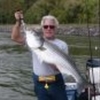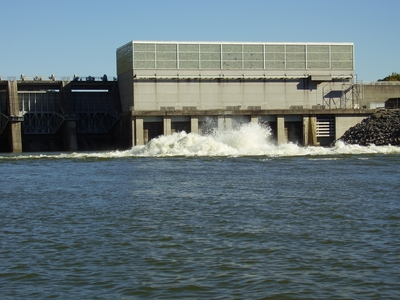Striper action can be hot in east Tennessee this time of year. Read on to see what our expert has to say about when and where to catch the big ones!
July can be one of the best months of the year for striper fishing in Tennessee. And, unlike many other species at this time of year stripers are predictable; they're almost always in the same place at the same time. Even better the warm water pushes their metabolism through the roof. They simply can't get enough to eat. Toss something near them and they'll pound it.
According to east Tennessee trophy striper specialist, Captain Chet Moore (www.stripersandmoore.com), all these factors combine to make this the time of year to catch a wall-hanger, your striper of a lifetime. "Summertime is about as good as it's going to get for big, trophy sized stripers around here," he says.
"I usually fish below the dams along the Tennessee River impoundments in July and August. The fish are predictable and they're usually feeding. That means they're catchable. Two of the best spots are below the dam on Fort Loudon Reservoir and below the dam on Watts Bar Reservoir. But there's also a good spot on the Clinch River Melton Hill Reservoir that'll put you on some big ones too."
Moore continues on to explain that stripers can be caught in the main reservoirs but they tend to be smaller than those below the dams. And, on the main reservoirs their survival rate is so low in July and August that it's basically a death sentence to catch one of them. He doesn't do it.
Fort Loudon Reservoir, located near Knoxville, offers anglers an unparalleled opportunity to catch and release quality stripers. According to Moore, power generation is the place to start if you want to fish this venue successfully. Generation typically occurs all day here but the best fishing is early in the morning, right after they fire up the generators to provide power for the daytime heat.
It's best to arrive early no later than 5:30 a.m. and collect lots of fresh bait. That's not a difficult task; motor over to the Tellico dam just down river and to the left- and net some from in front of the large round pipe that protrudes from the center of the dam. There's usually a wide variety to be had. Keep the big threadfin and gizzard shad you collect but make sure you release anything else. They're generally worthless as bait and might be illegal as well.
If you get to the Fort Loudon dam when they start the generators and before the sun rises there'll likely be a hot topwater bite along the flood gate walls. The stripers drive shad to the surface where they slaughter them with abandon for about 45 minutes immediately after daylight.
Moore recommends tossing a thin, pencil popper style bait into the slack water right in the thick of things. Bring it back fast, with plenty of splash.
When the topwater bite slows it's time to hit the boils. But to fish them effectively you'll need to understand the concept of a seam. A seam is a three to four foot wide slippage, or pathway, in the water's flow. It's a kind of slack water area between two faster moving flows. It looks like what it's called, a seam.
The object of fishing a seam is to get your bait down to where the big ones are hiding before the strong current coming off the generators pushes your bait left or right of the seam. The fish hide in the slower moving seams and eat food pushed out from the turbines. They won't venture into the fastest moving water.
To do this requires heavy weights and heavy tackle. Weights of 4, 5 or even 6 ounces are common. They are typically tied about 15 inches below the bottom loop of a three-way swivel using 14 pound test line. From the center loop there's a 36 inch piece of 25 to 30 pound test line that runs out to a large wire circle hook circle hooks reduce the mortality rate of released stripers - usually something between 3/0 and 5/0. Of course, the upper loop is tied to the main 20 to 25 pound test line running back to your reel.
Long, medium heavy action rods are the norm. If you're good, a baitcaster will suffice. If you lack experience stick with open-faced spinning tackle. It'll give you less trouble in the turbulent waters.
Once the turbines are brought online and the water starts to boil, motor towards the action and position your boat so that you can cast into the seam. The idea is to toss a 5 or 6 inch shad into the middle of the seam, as close to the front of the dam as possible, and allow the assembly to sink quickly towards the bottom.
If you are inexperienced this will require some practice. Keep trying until you get it right. There are almost always stripers to be had in a seam. It's worth the effort.
Once your bait is in place hold the boat steady as the bait works its way downstream. This will require using the big motor for control and safety. After a pass or two you should have the technique down and, hopefully, a striper or two to your credit.
The best place to fish below the dam at Melton Hill is off to the left side of the center boil. Cast toward the dam wall, placing your bait between the center boil and the wing wall. Let out enough line to get the rig to the bottom as quickly as possible. Your bait should move first towards the wing wall and then begin moving downstream.
If you don't get a bite within a few casts move over between the first and second boils. The water is easier to manage here so take your time. If the shad rig doesn't produce try a jig or another type of sinking artificial lure. Work this area carefully. It's a great place to hook the striper of a lifetime.
Melton Hill is also a great place to drift fish. Use the same type of rig and bait. Allow it to drift with the boat downstream with the current. This is also a good way to hang up in the mess of debris along the bottom. Hang-ups can be held to a minimum if you keep your line running at a 45 degree angle from the boat and relatively tight. Your sinker should bounce along the bottom in a lazy, natural sort of way.
Now, a quick word of warning: fishing below the dam is not for wimps and it's not for the careless. It's a two man operation and one that requires each angler to pay attention to what's going on around him or her. And always, without exception, wear a life jacket. Survival time in these waters is measured in a mater of minutes, short minutes, even for the best of swimmers.
Another great Tennessee River impoundment for some hot summertime striper action is below the dam at Watts Bar Reservoir, located south of Fort Loudon near Rockwood in Roane County. This one fishes much like its northern neighbor except that catching and fishing the live bait is a bit different. In fact it's a fishing experience in and of itself.
That's because Watts Bar is skipjack territory. According to Moore these baitfish are a delicacy to stripers, something that quite literally drives the big ones crazy. "Skipjacks are the forage of choice on Watts Bar. The stripers love them. They'll catch big, heavyweights when nothing else will," he says.
But fishing with skipjacks is a two-stage process. First you need to catch them, then you need to quickly fish with them.
Catching them is mostly a matter of casting Sabiki bait catching rig or a small crappie jig. They'll hit almost anything you toss if it moves along naturally in the current and has a little flash to it. When in doubt about what to throw choose a small, brightly colored jig with a couple of strips of Mylar on the hook.
Light spinning tackle works best for this. Use six or eight-pound-test line and you'll be good to go. Actually this can be a lot of fun in and of itself. Relax and have a good time, and a few laughs, while you're catching them. It's a great way to break the day. Skipjacks fish pretty good and they jump high and often. (They aren't called hillbilly tarpon for nothing.)
After they're caught skipjacks only live for a few minutes. Don't try to catch more than one or two before you start striper fishing. Immediately rig them and move towards the seam. Fish just like you would below the dam at Fort Loudon, and don't be shy about the size skipjack you use for bait. A big one maybe 12 inches or more will often catch a big striper maybe 30 pounds or more.
Now, another great place to catch summertime stripers, according to Moore, is below the dam at Melton Hill Reservoir on the Clinch River. Fish it exactly the same way as you would fish Fort Loudon and Watts Bar except that there's a small pond on the left side heading downstream that deserves your attention. On a good day here you can wear yourself out in just a couple of hours.
Don't let the heat of summer get you down. Go striper fishing you'll be glad you did!




